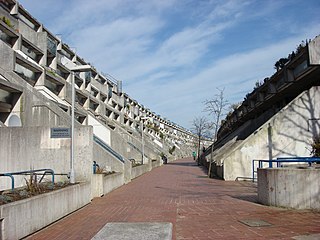
The Royal Society of Edinburgh is Scotland's national academy of science and letters. It is a registered charity, operating on a wholly independent and non-party-political basis and providing public benefit throughout Scotland. It was established in 1783. As of 2017, it has more than 1,660 Fellows.
The year 1978 in architecture involved some significant architectural events and new buildings.

Edinburgh College of Art (ECA) is one of eleven Schools in the College of Arts, Humanities and Social Sciences at the University of Edinburgh. Tracing its history back to 1760, it provides higher education in art and design, architecture, history of art, and music disciplines for over two thousand students, and is at the forefront of research and research-led teaching in the creative arts, humanities, and creative technologies. ECA comprises five subject areas: School of Art, Reid School of Music, School of Design, School of History of Art, and Edinburgh School of Architecture & Landscape Architecture (ESALA). ECA is mainly located in the Old Town of Edinburgh, overlooking the Grassmarket; the Lauriston Place campus is located in the University of Edinburgh's Central Area Campus, not far from George Square.

McKim, Mead & White was a prominent American architectural firm that thrived at the turn of the twentieth century. The firm's founding partners were Charles Follen McKim (1847–1909), William Rutherford Mead (1846–1928) and Stanford White (1853–1906). They hired many other architects, partners, associates, designers and draftsmen, who came to prominence during or after their time at the firm.

William Sutherland Maxwell was a well-known Canadian architect and a Hand of the Cause in the Bahá'í Faith. He was born in Montreal, Quebec, Canada to parents Edward John Maxwell and Johan MacBean.

Denise Scott Brown is an American architect, planner, writer, educator, and principal of the firm Venturi, Scott Brown and Associates in Philadelphia. Scott Brown and her husband and partner, Robert Venturi, are regarded as among the most influential architects of the twentieth century, both through their architecture and planning, and theoretical writing and teaching.

Stone, Carpenter & Willson was a Providence, Rhode Island based architectural firm in the late 19th and early 20th Centuries. It was named for the partners Alfred E. Stone (1834–1908), Charles E. Carpenter (1845–1923). and Edmund R. Willson (1856–1906). The firm was one of the state's most prominent.

The Alexandra Road estate, properly known as the Alexandra and Ainsworth estate, but often referred to as Rowley Way, the name of its main thoroughfare, is a housing estate in the London Borough of Camden, North West London, England. It was designed in 1968 by Neave Brown of Camden Council's Architects Department. Construction work commenced in 1972 and was completed in 1978. It is constructed from site-cast, board-marked white, unpainted reinforced concrete. Along with 520 apartments, the site also includes a school, community centre, youth club, heating complex, and parkland.

Wyndham Court is a block of social housing in Southampton, England. It was designed by Lyons Israel Ellis for Southampton City Council in 1966, and is located near Southampton Central station and the Mayflower Theatre. Wyndham Court includes 184 flats, three cafes or restaurants and 13 shops, and was completed in 1969.
Alan Harold Colquhoun (1921-2012) was an English architect, historian, critic and teacher.
The year 2018 in architecture involved some significant architectural events and new buildings.
Events from the year 1807 in Scotland.

Araldo Cossutta was an architect who worked primarily in the United States. From 1956 to 1973 he worked at the firm I. M. Pei & Partners. I. M. Pei has been among the most honored architects in the world. Cossutta was Pei's associate and ultimately his partner in the first phase of Pei's career. He was responsible for some of the firm's best-known designs from that era, including three that have received "landmark" designations in recent years. In 1973 he and Vincent Ponte left Pei's firm to form Cossutta & Ponte, which ultimately became Cossutta and Associates. The new firm designed the Credit Lyonnais Tower in Lyon, France (1977) and the Tower at Cityplace (1988) in Dallas, Texas, among other commissions.
Neave Brown was an American-born British architect and artist. He specialized in modernist housing. Brown is the only architect to have had all his UK work listed: row houses in Winscombe Street, the Dunboyne Road Estate and Alexandra Road Estate, all located in Camden.
Yorke Rosenberg Mardall was a British architectural firm established by F. R. S. Yorke (1906-1962), Eugene Rosenberg (1907-1990) and Cyril Mardall (Sjöström) (1909-1994) in 1944.
John Garrett Ellis, AIA, RIBA is an Anglo-Californian architect, urban designer and teacher. He grew up in London, the son of Tom Ellis, the Brutalist architect and was a student at Cambridge University 1965-70 under Sir Leslie Martin, Colin St John Wilson and David Roberts. While a student he ran the Architectural Society and invited numerous distinguished architects to speak including Louis Kahn, the Russian Constructivist Berthold Lubetkin and the American Jack MacAllister. In 1968 he and four other students drove 12,000 miles from London to Moscow and Leningrad and out through Scandinavia to research the work of the Russian Constructivist architects. At Cambridge he was also taught by Richard Saul Wurman who offered him a position in his office in Philadelphia in the summer of 1969 where he met his late wife Becky, an art historian.
Susan Jane "Su" Rogers, is a British designer and educator. She was a co-founder and partner during the 1960s and 1970s in two architectural practices Team 4 and Richard + Su Rogers. From 1986 to 2011, she was a partner in Colquhoun, Miller and Partners. Rogers was a member of the team that won the design competition for the Pompidou Centre in the 1970s, and she co-designed the concept Zip-Up House in the 1960s. She was also responsible for two notable commissions from her parents: Creek Vean and Pillwood House, which are both Grade II* listed buildings.













